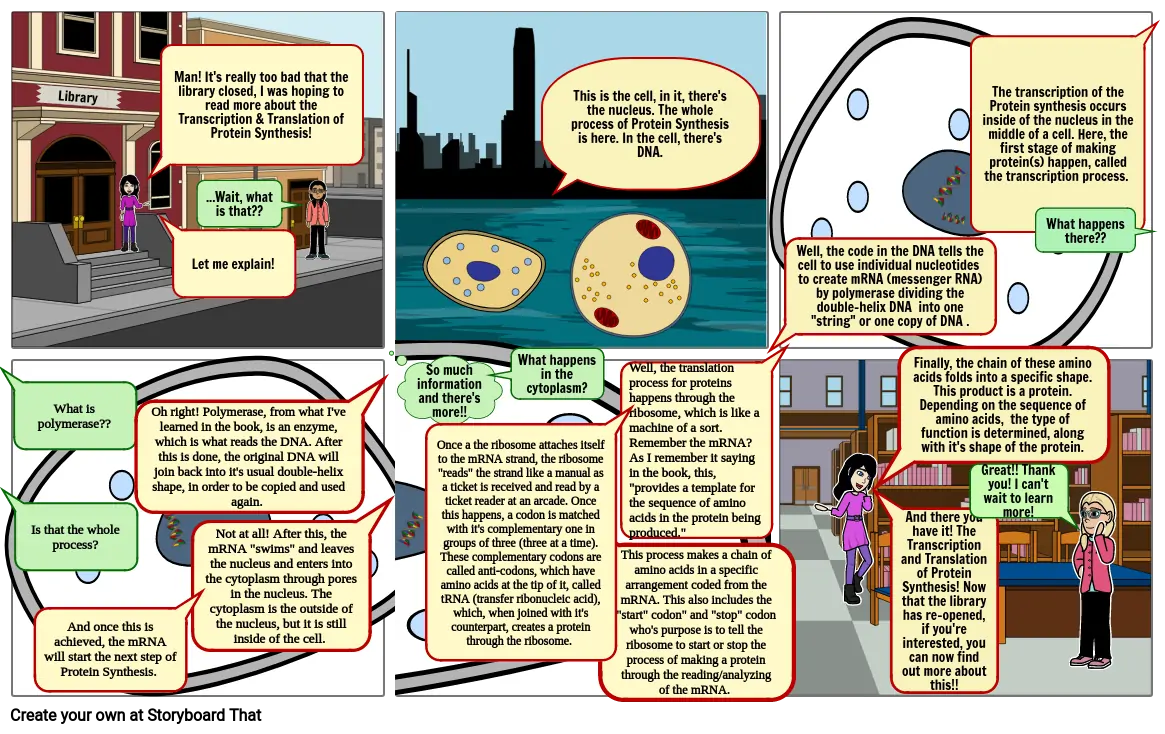T&T DNA Replication

Testo Storyboard
- Library
- Man! It's really too bad that the library closed, I was hoping to read more about the Transcription & Translation of Protein Synthesis!
- Let me explain!
- ...Wait, what is that??
- What happens in the cytoplasm?
- This is the cell, in it, there's the nucleus. The whole process of Protein Synthesis is here. In the cell, there's DNA.
- Well, the translation process for proteins happens through the ribosome, which is like a machine of a sort. Remember the mRNA? As I remember it saying in the book, this, "provides a template for the sequence of amino acids in the protein being produced."
- Finally, the chain of these amino acids folds into a specific shape. This product is a protein. Depending on the sequence of amino acids, the type of function is determined, along with it's shape of the protein.
- What happens there??
- The transcription of the Protein synthesis occurs inside of the nucleus in the middle of a cell. Here, the first stage of making protein(s) happen, called the transcription process.
- What is polymerase??
- Is that the whole process?
- And once this is achieved, the mRNA will start the next step of Protein Synthesis.
- Oh right! Polymerase, from what I've learned in the book, is an enzyme, which is what reads the DNA. After this is done, the original DNA will join back into it's usual double-helix shape, in order to be copied and used again.
- Not at all! After this, the mRNA "swims" and leaves the nucleus and enters into the cytoplasm through pores in the nucleus. The cytoplasm is the outside of the nucleus, but it is still inside of the cell.
- So much information and there's more!!
- Once a the ribosome attaches itself to the mRNA strand, the ribosome "reads" the strand like a manual as a ticket is received and read by a ticket reader at an arcade. Once this happens, a codon is matched with it's complementary one in groups of three (three at a time). These complementary codons are called anti-codons, which have amino acids at the tip of it, called tRNA (transfer ribonucleic acid), which, when joined with it's counterpart, creates a protein through the ribosome.
- This process makes a chain of amino acids in a specific arrangement coded from the mRNA. This also includes the "start" codon" and "stop" codon who's purpose is to tell the ribosome to start or stop the process of making a protein through the reading/analyzing of the mRNA.
- Well, the code in the DNA tells the cell to use individual nucleotides to create mRNA (messenger RNA) by polymerase dividing the double-helix DNA into one "string" or one copy of DNA .
- And there you have it! The Transcription and Translation of Protein Synthesis! Now that the library has re-opened, if you're interested, you can now find out more about this!!
- Great!! Thank you! I can't wait to learn more!
Oltre 30 milioni di storyboard creati

